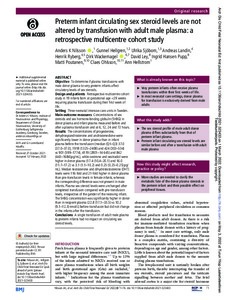Preterm infant circulating sex steroid levels are not altered by transfusion with adult male plasma: a retrospective multicentre cohort study
Nilsson Anders K.; Hellgren Gunnel; Sjöbom Ulrika; Landin Andreas; Ryberg Henrik; Wackernagel Dirk; Ley David; Pupp Ingrid Hansen; Poutanen Matti; Ohlsson Claes; Hellstrom Ann
https://urn.fi/URN:NBN:fi-fe2022081154985
Tiivistelmä
Objective
To determine if plasma transfusions with male donor plasma to very preterm infants affect circulatory levels of sex steroids.
Design and patients
Retrospective multicentre cohort study in 19 infants born at gestational age <29 weeks requiring plasma transfusion during their first week of life.
Setting
Three neonatal intensive care units in Sweden.
Main outcome measures
Concentrations of sex steroids and sex hormone-binding globulin (SHBG) in donor plasma and infant plasma measured before and after a plasma transfusion and at 6, 12, 24 and 72 hours.
Results
The concentrations of progesterone, dehydroepiandrosterone and androstenedione were significantly lower in donor plasma than in infant plasma before the transfusion (median (Q1-Q3) 37.0 (37.0-37.0), 1918 (1325-2408) and 424 (303-534) vs 901 (599-1774), 4119 (2801-14 645) and 842 (443-1684) pg/mL), while oestrone and oestradiol were higher in donor plasma (17.4 (10.4-20.1) and 16.0 (11.7-17.2) vs 3.1 (1.1-10.2) and 0.25 (0.25-0.25) pg/mL). Median testosterone and dihydrotestosterone (DHT) levels were 116-fold and 21-fold higher in donor plasma than pre-transfusion levels in female infants, whereas the corresponding difference was not present in male infants. Plasma sex steroid levels were unchanged after completed transfusion compared with pre-transfusion levels, irrespective of the gender of the receiving infant. The SHBG concentration was significantly higher in donor than in recipient plasma (22.8 (17.1-33.5) vs 10.2 (9.1-12.3) nmol/L) before transfusion but did not change in the infants after the transfusion.
Conclusions
A single transfusion of adult male plasma to preterm infants had no impact on circulating sex steroid levels.
Kokoelmat
- Rinnakkaistallenteet [27094]
